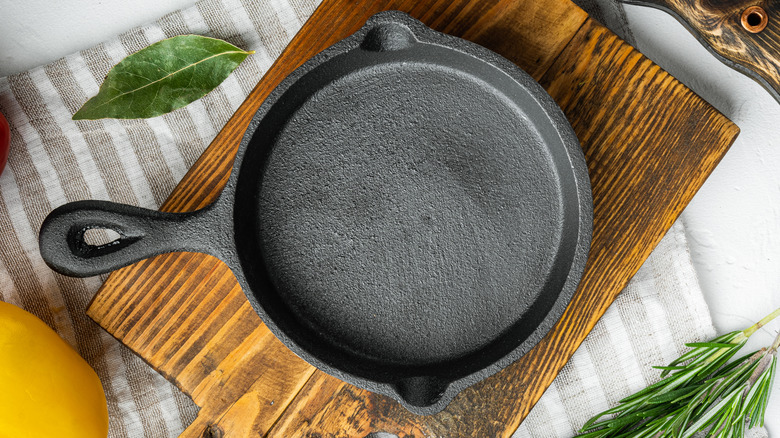
Ilia Nesolenyi/Getty Images
Two-time James Beard award winner, cookbook author, restaurateur, and celebrity chef Art Smith knows a thing or two about cast iron cooking. “I grew up in the South where cast-iron pots and skillets are kitchen staples and treasured family heirlooms,” he said. He further explained that he watched and learned to cook from his mother and aunts, “there was always a cast iron pan in the oven, on the stove top, or the outside grill making something delicious.”
A cast iron pan is a simple, one piece cooking vessel with no moving parts or attachments. It often doesn’t cost a lot of money, and if treated well, it lasts pretty much forever. The properties of cast iron make it the ideal cooking vessel for many ingredients. When seasoned properly, it has a robust nonstick surface that gets better with every use. It heats evenly and retains temperature consistently, even when cold food is added. It is slow to heat up and slow to cool down. It can be preheated on the stove or in the oven without damaging or warping. In short, it’s a nearly indestructible power house in the kitchen.
Yet some of these same characteristics that make it ideal for cooking some ingredients are the reasons why a cast iron pan isn’t a good choice for cooking other ingredients.
Cast iron is the best choice for steaks and other meat

JRP Studio/Shutterstock
Cast iron pans are one of Executive Chef Mike Tsarnas’ favorite tools in his kitchen, both at home and in his restaurant, Gabriella’s Italian Steakhouse. “It holds heat so well and creates a perfect sear on meats,” he said. He uses cast iron to cook thick-cut steaks, burgers, chops, and fried chicken.
The heavy pan can retain heat for a long time, even adding a cold piece of meat won’t cause the pan’s surface temperature to dip. To prepare for a high-heat sear — whether its a steak, pork chop, or burger — it’s crucial to preheat the pan. This can be done on the stove or in the oven — for up to 30 minutes — so when that raw meat hits the sizzling hot pan, the juices are sealed in by a delicious crust. While most steaks are cooked on the stove top, you can also use a cast iron pan to cook a steak in the oven.
Skillet cornbread has all the right textures
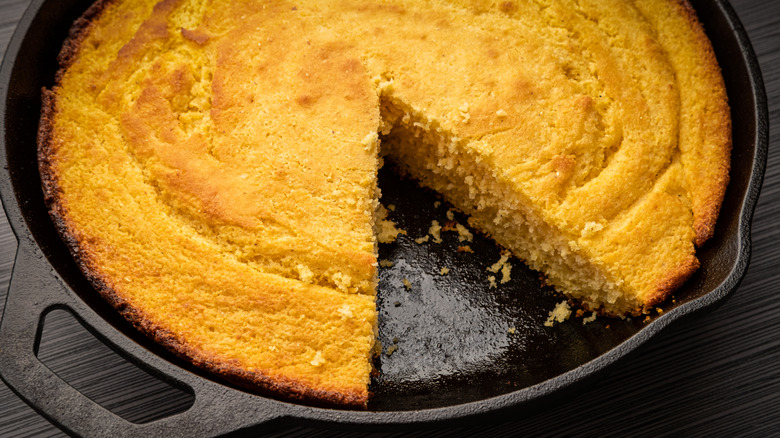
Bruce Peter/Shutterstock
The preheating technique used on steaks is also what gives skillet cornbread its contrasting crispy golden edges and moist crumb middle. Bobby Flay has discussed how he makes cornbread by first placing the empty pan into a hot oven while he prepares the batter. He drops butter into the pan — which melts instantly to coat the pan — before pouring in the batter. Eighteen minutes later he pulls out golden corn bread that has caramelized browned edges and an evenly cooked center.
While the cast iron pan is great for making cornbread, it is not great for storing cornbread. Leaving food in a cast iron pan can be detrimental for both the food and the pan. The moisture from the food can break down the nonstick seasoning and even rust the pan. And food left too long in the pan will take on a bitter, metallic taste, especially if it is moist or acidic. Leaving food for a few hours is generally okay, but before you close the kitchen for the night, be sure to transfer the leftovers to a different container and then wash and thoroughly dry your pan. It’s all part of following Chef Tsarnas’ admonition to “treat it [the pan] right and it’ll last you a lifetime.”
Cast Iron makes the best grilled cheese sandwiches and burgers
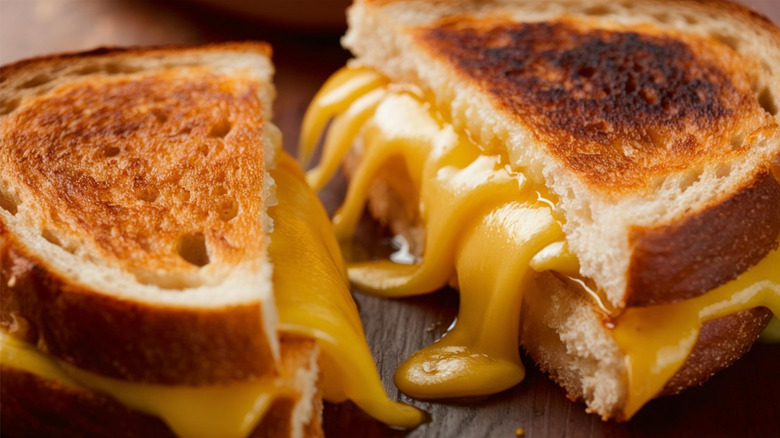
Food magic/Shutterstock
A pan that keeps a steady temperature? Yes, please! That’s the key to a perfectly melty, perfectly golden grilled cheese sandwich. A perfect crust is possible with the liberal application of butter or mayo — either will facilitate uniform browning and added flavor to your sandwich. If the cast iron pan is properly preheated to medium heat, the cheese will yield quickly to the heat permeating from multiple sides. If you are of the opinion that there’s no such thing as too much cheese on a hot sandwich, try this extra step that’ll make grilled cheese taste divine.
Cast iron is also the cooking vessel of choice for both Chef Tsarnus and Chef Smith when cooking hamburgers. Chef Tsarnus said cast iron “gives that nice crust and depth of flavor you just can’t get with other pans.”
Preheating the pan is essential for getting a good caramelized crust on a burger that quickly seals in the meat’s flavorful juices. The cast iron skillet should be preheated on a burner on medium-high heat for 5-7 minutes. The addition of one or two tablespoons of vegetable oil (or any other cooking oil with a high smoke point) just before setting the patty in the pan helps form a crisp sear. With the hot surface and the seared crust, the burger will cook quickly — three to four minutes each side — and not dry out.
Fish is too delicate for a cast iron pan

Milanchikov Sergey/Shutterstock
Because Chef Smith grew up using them, he says he can cook almost anything in a cast iron pan — but that doesn’t mean it’s always the best choice for every ingredient. “As a [general] rule, sauteing really delicate fish such as sole and cod are not good choices,” he said.
A cast iron pan can lose some of its seasoning and create patches of nonstick surface, making it risky to cook delicate fish. Cast iron isn’t as forgiving as a saute pan if the fish sticks, and trying to scrape it out will just break up the fillet into a mess.
A thick or oily fish skin can protect the flesh from the pan’s surface — and will sear well, but it doesn’t solve the other problem with fish … the smell. The nonstick layer formed during the cast iron seasoning process prevents food from sticking, but it is made of oil, after all, which naturally absorbs strong flavors. Especially when cooking at high heat, those fish oils can inadvertently get baked into the seasoning. The cooking surface of a cast iron pan also has microscopic crannies where food particles can be trapped even after you think you’ve cleaned the pan completely. So, the next time you heat up the pan, eau-de-fish will be released, and you run the risk of tainting your breaded chicken or skillet brownies with a fishy taste.
Eggs may stick in cast iron

ZCOOL HelloRF/Shutterstock
Eggs are another ingredient that can be problematic when cooked in a cast iron skillet. It takes a practiced hand and lots of “eggs”perience to know how to control the heat in the pan for something as delicate as eggs, which require precise temperature control. Because of the thermal properties of cast iron, you cannot make adjustments to the temperature easily. It is recommended to begin cooking eggs at moderate heat and then make adjustments up or down to prevent them from drying out or cooking too quickly. But cast iron takes more time to heat up and cool down than other pans and eggs not cooked at the correct temperature can turn out slimy, rubbery, tough or burned.
It’s also common for the seasoning on a cast iron pan to occasionally wear off. You’ll know this has happened when food begins to stick or if there are dull or sticky areas in the bottom of the pan. Chef Tsarnas suggests, if the pan or the chef is unseasoned, “Maybe skip eggs … at first. They tend to stick until your pan builds up that natural nonstick layer.” Luckily, the best way to keep cast iron seasoned is also the easiest.
Tomatoes may damage your cast iron pan’s seasoning

BearFotos/Shutterstock
Tomatoes are as acidic as acid rain, okay maybe that was an exaggeration, but you may want to think twice before you cook them in your cast iron pan. Chef Tsarnas said he learned that lesson the hard way. “I once made a tomato sauce in cast iron. I realized acidic foods don’t mix well with a cast iron.”
Tomatoes can be problematic, not only for the integrity of the pan but for the taste of the food. What happens is the acid of the tomato can strip away the layer of seasoning in your pan. Also, a metallic flavor from the pan can leech into your food. However, length of exposure is a main factor whether either of these occur. If you cook tomatoes, tomato sauce, or tomato juice for a short amount of time, there’s less opportunity to do damage. According to the experts at America’s Test Kitchen, you’ve got less than 30 minutes. Tomato sauce was simmered in a cast iron pan and taste-tested at 15 minute intervals. The sauce tasted fine at 15 minutes but at 30 minutes, tasters detected a bitter metallic taste in the sauce.
Even if you limit the amount of time tomatoes stay in your cast iron pan, just to be safe, empty the pan as soon as possible and rinse it immediately to neutralize the acid attack. Alternatively, you can cook some bacon in the pan to sizzle away any leftover acid in the pan.
Vinegar, lemon, and wine are a no-go

Menna/Shutterstock
Tomatoes aren’t the only acidic ingredient that should be used with care in a cast iron pan. Modern palettes love a bit of acid in a dish to balance or emphasize flavors, but acid can damage a cast iron pan’s seasoning. “Highly acidic foods like tomatoes, vinegar-based sauces, or wine reductions can strip the seasoning and affect the taste if the pan isn’t well-seasoned,” Chef Tsarnas said. Without the seasoning to protect the pan, food is more likely to stick and unseasoned pans are also more likely to rust.
To protect your cast iron cooking vessels, don’t use them for dishes with BBQ sauce, wine reductions, or citrus sauces. Need another reason? Lemons easily take on a bitter taste of iron when cooked in a cast iron pan. If you must use acidic ingredients, don’t leave them in the pan for longer than necessary. If possible, delay adding the lemon juice or vinegar or another acidic ingredient until near the end of the cooking time, a technique which can be a game changer for soup.
Some ingredients can get you into a sticky situation

Nadezhda Nesterova/Shutterstock
Food will stick if your cast iron is not well-seasoned, says Chef Smith. He warns that you should not use a cast iron pan that is unseasoned. “Just do not do it,” he said. “Good quality cast iron is an investment. Season it properly and it is the best non-stick pan you will ever use.”
Pans should be seasoned regularly, but if neglected, they can come to a sticky end. If a pan’s seasoning has been compromised and you get stuck with a sticky mess while cooking something like pancakes, French toast, grits, or sweet and sour chicken, it may be difficult to get all of the food residue off the pan. Tiny particles, which can’t be seen, can remain in the tiny crevices of the pan’s cooking surface and disrupt its nonstick properties for the next use. There are several methods for cleaning your iron cookware. We think a light wash with soap is the best way to clean cast iron, or you can also use this common kitchen item to scrub your pan clean.
Soups, stews, and braises are too wet for cast iron
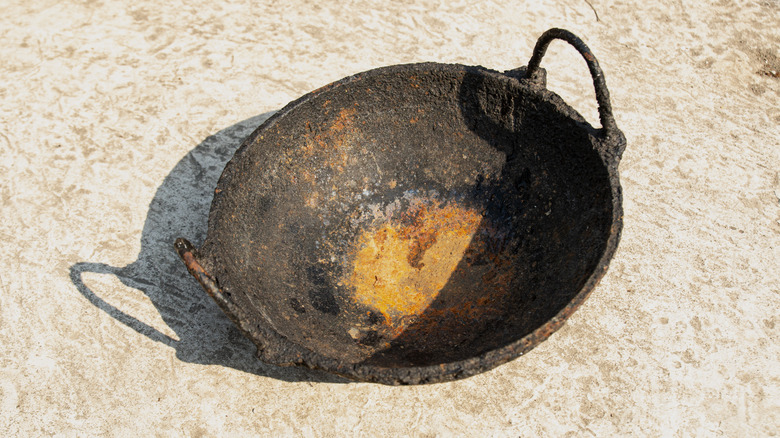
Sujon Mutsuddi/Getty Images
It makes sense that you don’t want to keep your iron cookware wet for too long — rust can begin to form in just a few hours. That’s why wet cooking methods like steaming, stewing, and braising are not good choices when using cast iron. The excess moisture and sustained high temperatures can break down the seasoning. That’s why you also shouldn’t soak cast iron pans in water to clean them either, Chef Tsarnas advises, or else it could damage the pan’s seasoning. (I didn’t know all these rules and warnings when I cooked in cast iron for the first time, and so I ruined a friend’s cast iron pot which I borrowed to take camping. I was inexperienced and I made all the mistakes)
Sometimes rust happens but it is no reason to throw out a pan. Surface rust can be safely removed — try cleaning your cast iron with this condiment – and pans can be re-seasoned so that they can be passed down through the generations.
Spinach and other high oxalate foods don’t play well with iron pans
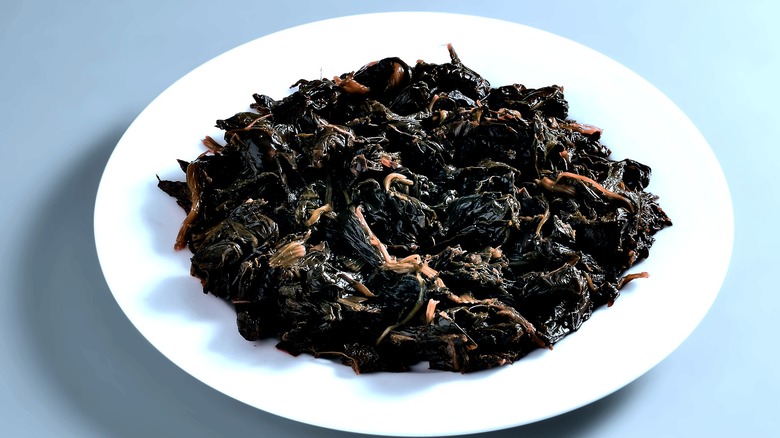
Antoniotruzzi/Getty Images
It is a good idea to avoid preparing foods high in oxalic acid in your cast iron pans. That advice makes sense when you realize that some rust removers contain oxalic acid as an active ingredient, though with a much more concentrated amount than what you find in food. You can even use this high oxalate vegetable to remove rust. Oxalic acid isn’t dangerous, though it can increase the risk of kidney stones for some people. Most people can safely eat foods that are high is oxalates which include spinach, tofu, potatoes, rhubarb, beets, raspberries, and Navy beans.
The unpleasant results of cooking foods high in oxalates in cast iron is the chemical reaction that occurs between the acid from the food and the iron in cookware to change the food’s appearance, like how spinach turns an unappetizing brown or black color. Additionally, the amount of iron naturally found in foods can increase when cooked in iron cookware, because iron from the pan seeping into the food. This can be an improvement as far as nutritional value, but can also cause a loss of color as in the case of beets, which are high in iron and tend to lose their characteristically bright color when cooked in iron cookware. Turmeric also can become discolored and take on a metallic taste when cooked in cast iron.
Desserts can be a disaster if you’re not careful

Brent Hofacker/Shutterstock
For Chef Smith, family stories are passed down through recipes, and through the family cookware. “Cast iron passed down through generations is a treasure-trove of family history,” he said. “If you are the custodian of such cookware, you are a lucky person. Make sure you pass it on and keep those experiences flowing through your family tree.”
Pancakes, johnnycakes, and Southern pies are some of the sweet recipes Chef Smith likes to cook in cast iron skillets. But many less experienced cooks are reluctant to bake sweets in the same pan they cooked garlic and rosemary potatoes in the night before, for fear of residual odors tainting their next recipe. Thoroughly cleaning the pan between uses should prevent such a mishap. You should heat the pan, after it has been washed, in a 400 degree oven for 10 minutes or so to cook out any remaining odors. Another foolproof solution that guarantees there will be no accidental flavor mishaps: have a cast iron pan for savory dishes and a separate cast iron pan specifically for desserts.
Another unwanted flavor that can ruin your dessert is the bitter flavor of burned sugar. The high heat of your sturdy cast iron can be the reason you turn to it for skillet cookies and brownies — just be careful not to overcook them. Be extra careful with recipes containing marshmallows because burned marshmallows are not fun to scrape off any pan.


Dining and Cooking